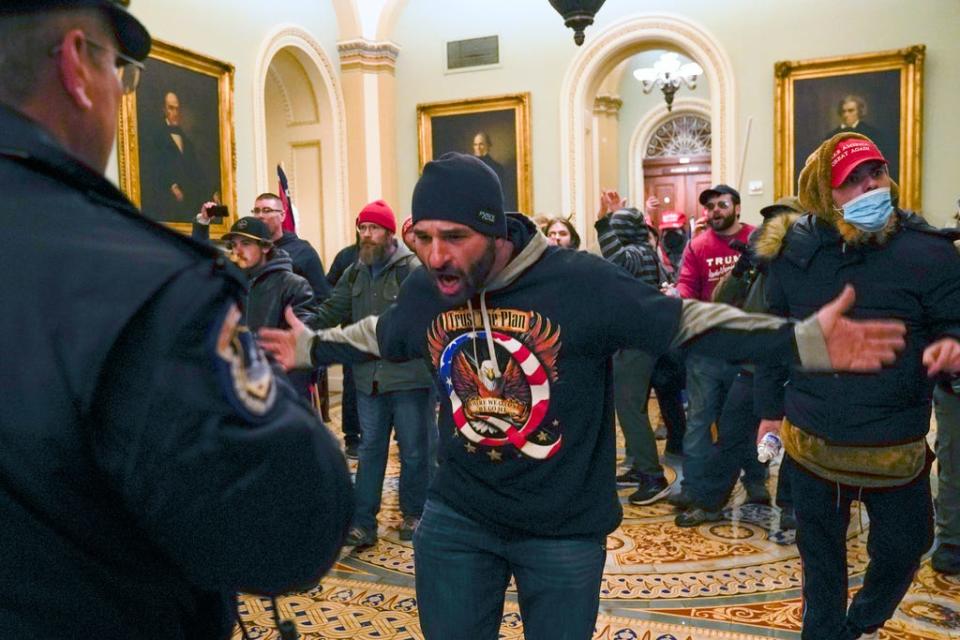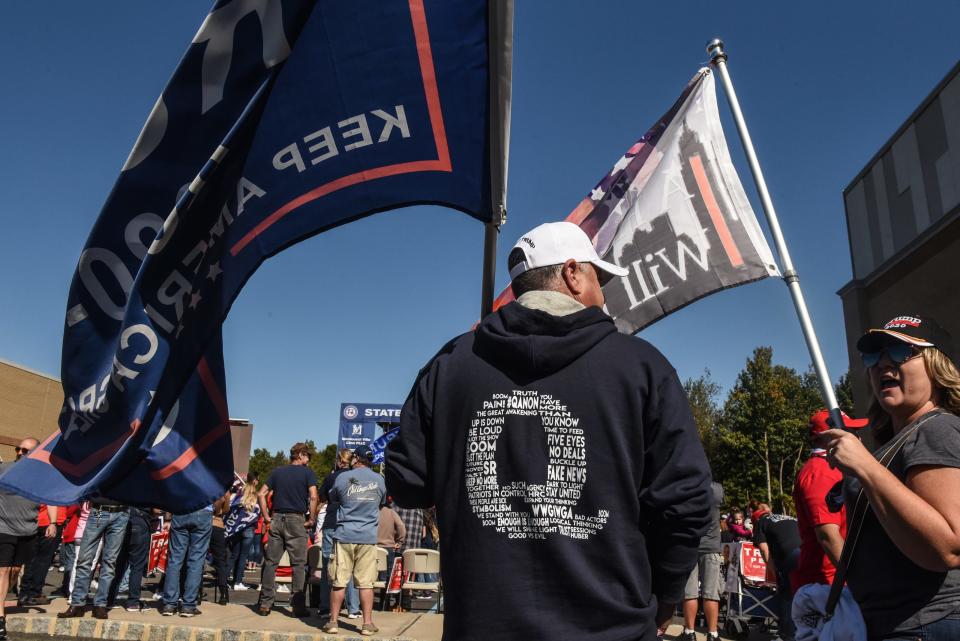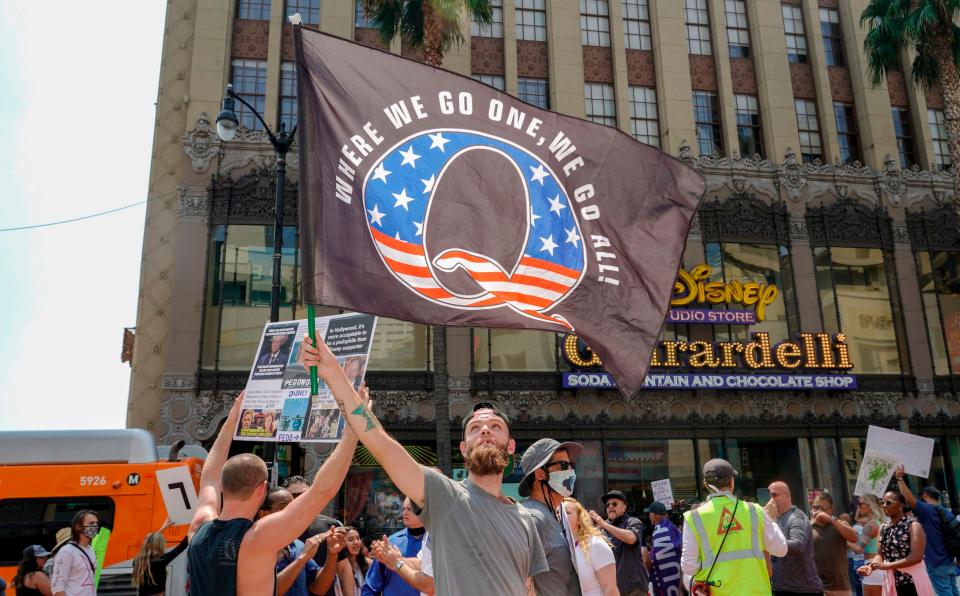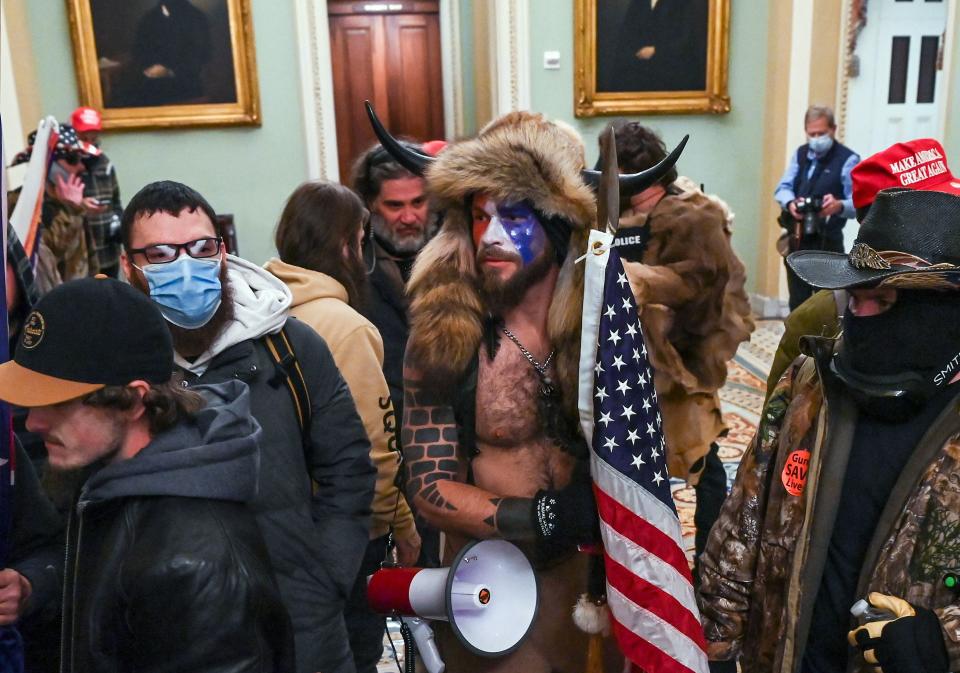QAnon followers distance themselves from the movement's most bizarre conspiracy theories as they rebrand
Donald Trump did not win the 2020 presidential election. Nor was he reinstated on March 4, the original inauguration day for presidents before 1933. President Joe Biden has not been outed as a lizard-person. There has been no “storm” leading to a roundup of Hollywood celebrities, the Clintons or any other members of a fictitious evil cabal of blood-drinking pedophiles.
In short, none of the absurd prophecies of the conspiracy theory known as QAnon, which an estimated 15% of Americans believe in, have come true. With so many unmet promises, the QAnon movement should be a relic of the political theater of the Trump administration.
Instead, QAnon is adapting to the post-Trump era. Its members are shedding the “Q” label that has united them, and they are trying to rewrite the brief history of the movement by falsely claiming the QAnon moniker never really existed — that it was created by the media to sully the reputation of conspiracy researchers.
Experts on conspiracy theories say that reflects a shift away from the most bizarre elements of the QAnon myth by some of the movement's most vocal supporters, driven in part by an effort to circumvent social media bans on QAnon propaganda. Meanwhile, the community of QAnon followers is embracing new conspiracy theories, from anti-vaccine tropes to lies about election fraud.
QAnon in hiding: QAnon has receded from social media, but it's just hiding
What is QAnon?: What is QAnon, the far-right conspiracy theory causing controversy at the RNC?

Experts warn that the movement formerly known as QAnon is metastasizing into a less conspicuous, larger and more powerful political force. Across the country, at the urging of movement leaders, QAnon adherents are running for local offices: the school board, city council, mayor.
“It is absolutely going to survive,” said Mike Rothschild, a conspiracy theory researcher who wrote a book on QAnon. “There’s no giving up. What they are doing is rebranding.”
The absurd conspiracy: A satanic cabal that murders children and drinks their blood
The QAnon conspiracy theory surfaced in late 2017 on the online message board 4Chan, with posts purported to be authored by someone who signed off with “Q,” a reference to a type of top-secret government security clearance.
The posts were wide-ranging and bizarre. They soon attracted a cottage industry of online soothsayers who claimed to be able to interpret what became known as “Q drops.” The focus of the drops was a conspiracy theory rooted in antisemitism: that a cabal of powerful satanic pedophiles, including George Soros, former President Barack Obama and Hillary Clinton, was trafficking children and feasting on their blood and adrenaline.
The cabal, the theory went, was opposed by a top-secret team within the government, led by Trump. Adherents believed a sudden event known as the “Storm” would see the pedophile cult leaders jailed.

Despite being wholeheartedly debunked, QAnon gained steam throughout 2018 and 2019, with members of the community gathering at conferences and rallies. Trump event attracted growing crowds of QAnon supporters, and by the 2020 election, the movement was estimated to be several million people strong.
When Trump lost, a small faction of the QAnon community wavered. On Jan. 6, when thousands of QAnon supporters joined a crowd of Trump loyalists in the insurrection, more of the faithful saw the light and abandoned their beliefs.
The insurrection failed to stop the election results from being certified. The "storm" never came. Trump quietly left office and Biden was inaugurated without incident.
Fact check: Conspiracy theory falsely says Biden arrested in plot to make Trump president
These were just the latest failed prophecies for a movement that has been defined by a total lack of validation. Again and again, watershed events predicted in Q drops failed to materialize. Yet the faithful donned QAnon T-shirts and bought bumper stickers reading “WWG1WGA,” a shorthand for their rallying cry: “Where We Go One, We Go All.”
“Every time there’s a major disaster, a disconfirmation of QAnon and there’s a shining opportunity for people to ... walk away from it, they don’t do it,” Rothschild said. “They double down, they dig in more. They find a reason to explain why the failure was actually a success, and that’s a very powerful aphorism because it means that you’re never wrong — you’re only temporarily wrong, you’ll be right in the end.”
The QAnon movement attempts to rewrite history
Recently QAnon influencers have tried to rewrite history by pretending the term QAnon never really existed.
Logan Strain, who has written about QAnon for years under the pseudonym “Travis View” and co-hosts a podcast on the movement, said this whitewashing stems from a September 2020 Q drop.
“It said that, ‘There is Q, and there are Anons, but there is no QAnon,’” Strain said. “It was very strange because Q had never objected to the term QAnon before, and this seemed like a weird sleight-of-hand, designed to delegitimize all the media coverage.”
Rothschild said the revisionism is nonsense.
“They were talking about themselves as QAnon right from the very beginning,” Rothschild said. “They threw around the term constantly. The Q poster used the term constantly. The most popular pro-Q book is, ‘QAnon, an Invitation to the Great Awakening.’”

This attempt at erasure epitomizes the QAnon movement, experts said.
By claiming QAnon never existed, the very people pushing those beliefs can avoid having to explain their support for a ridiculous conspiracy theory that has never come to pass, Strain said.
“Whenever a QAnon follower encounters a news article about QAnon, they now react not by examining the content of the article, but by saying, 'There is no QAnon,'” Strain said. “It’s the same kind of dismissal as ‘fake news.’”
The disavowal has a more practical application, Rothschild said. Since Twitter and Facebook banned millions of QAnon-affiliated accounts and started clamping down on conspiracy theories, the QAnon label and hashtags like #WWG1WGA have become targets.
It's safer for the QAnon community to unite under vague terms like "Save the Children" that are harder for social media companies to police.
As QAnon expands beyond its origins — there have been no Q drops since Dec. 8 — believers have united under new conspiracy theories. People who once shared interpretations of vague posts authored by Q now share lies about election fraud, vaccines and COVID-19.
Fact check: False QAnon-related conspiracy theory claims Arizona ballots are secretly watermarked
QAnon supporters run for local office
In February, the left-leaning watchdog Media Matters for America claimed that QAnon message boards and influencers were encouraging their followers to run in local elections.
The effort stemmed, the researchers said, from a podcast interview by political operative and former Trump strategist Steve Bannon with Dan Schultz, an attorney and a member of the Arizona Republican Party. Schultz and Bannon said filling these positions with Republicans could result in a grassroots takeover of the Republican Party.
QAnon adherents heeded the call. They have run for school board positions around the country, winning some. A school board member in Grand Blanc, Michigan, was outed in November for posting incessantly about QAnon on social media. In June, the National Education Association, the largest teacher's union in the country, published an article asking, “Is QAnon radicalizing your school board?”
It read: “Across the county, conspiracy theorists and proponents of fake news are winning local elections. And their new positions give them a powerful voice in everything from local law enforcement to libraries, trash pickup to textbook purchases.”
It’s not just local races. Media Matters for America researchers recently compiled a list of 42 candidates for Congress in 2022 who have embraced QAnon.
A new voting bloc
While a minority of political candidates have voiced wholehearted support for QAnon, and even fewer have won office, experts on the movement say it will continue to have an impact on politics.
Political candidates, particularly Republicans, ignore or rebuff QAnon at their peril, said Jared Holt, a fellow at the Atlantic Council's Digital Forensic Research Lab who has studied the movement since it began.
“It has to be catered to, otherwise all that energy will cannibalize them,” Holt said. “It puts Republicans in the position where they have to make the calculation of whether they want to channel some of that energy — as a lot of Republicans are choosing to do — or make the decision to posture as a principled, values-oriented Republican.”
Back in 2020, candidates in conservative districts had a third option: They could feign ignorance, claiming they had vaguely heard of QAnon but couldn’t say one way or another whether they supported it. That's what Trump did last August.

Jan. 6 changed that.
The image of the “QAnon Shaman” Jake Angeli, whose legal name is Jacob Chansley, adorned in a horned beavertail hat, his face painted red, white and blue as he stormed the Capitol rotunda, practically made it impossible for political candidates to feign ignorance of the movement.
QAnon's lasting impact
Conspiracy theories have long been part of American politics. For two or three years, QAnon managed to unite disparate, desperate conspiracy theorists under what has been termed a “big tent” conspiracy theory, experts said.
Some of the people inside that tent are now trying to distance themselves from the actions of people like Angeli, and from the original ideas of Satan-worshipping, child-eating pedophiles.
But the lasting impact of QAnon is that unification, experts said.
“They no longer talk about it in terms of expecting Q to come and save the day, or ride in on a white horse,” Strain said. “They talk about it in terms of saying, ‘Q woke me up.’ They say they had a conversion experience because of their involvement with Q, and they’re now working as digital soldiers to spread the disinformation that they think of as the truth.”
This article originally appeared on USA TODAY: QAnon conspiracy theory evolves for post-Trump era

 Yahoo Movies
Yahoo Movies 
